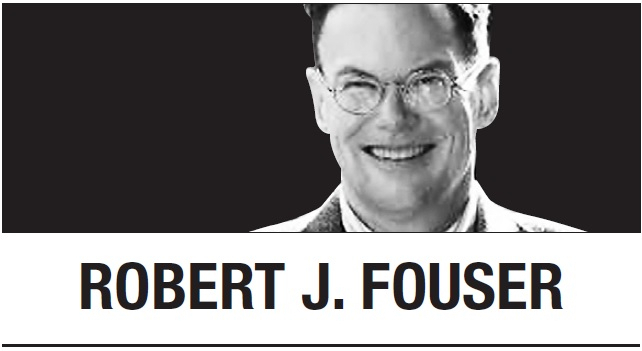
After years of sitting behind a wall, the large empty space in Songhyeon-dong opened to the public on Oct. 7 this year. During the Japanese colonial period, the space was used for housing for employees of the Joseon Shiksan Bank. From liberation in 1945 to 1997, it was a housing compound for US diplomats. After the diplomats moved out, Samsung Life Insurance bought the land and then sold it to Korean Air, who planned to develop it into a luxury hotel. As opposition to those plans grew, the City of Seoul began negotiations to turn the space into a public space. Negotiations ended in the city’s favor, and the city has opened it as a park for two years, after which a museum for the Lee Kun-hee art collection will be built there.
Aside from Joseon-period royal palaces, the park is now one of the largest green spaces in the historic center of Seoul. As the largest green space without a wall controlling access, the space creates a refreshing feeling of openness in the busy and crowded center of Seoul. It joins the ranks of important park developments in Seoul since democratization in 1987. Turning the concrete Yeouido Plaza into a nature park was first in 1999. This was followed by the uncovering of Cheonggyecheon in 2005, the development of the Gyeongui Line Forest Park in 2016, and, most recently, the Seoullo 7017 elevated park in 2017.
The problem, of course, is that the current park, with is beautiful fields of full-blooming cosmos, will be around for only two years. In 2025, it will again go behind walls and emerge two years later with a museum building above and an underground parking lot for tourist buses below. The museum will not fill the space, and there will still be plenty of greenery, but a museum will create a curated, controlled space, which will contrast with the sweeping openness of the space now.
Empty spaces in big cities invite development, and Seoul is no exception. This explains why Korean Air tried for so long to develop it into a hotel and why the City of Seoul has decided to develop it into a museum. At a deeper level, empty spaces and cities do not mix well because cities are built environments where people live and interact. This is why arguments for leaving large spaces empty in cities usually lose.
In the wake of the COVID-19 pandemic, Seoul is also experiencing another kind of emptying as any walk through Jongno and Myeong-dong, the historic retail centers of Seoul, reveals. Rows of empty stores with “for rent” signs line the streets with few people. The is starkest in these areas but has also affected many other retail districts, old and new alike. E-commerce, lifestyle changes, and an aging population explain much of the change and these megatrends make it hard to expect a rapid revival of city street life.
Seoul, of course, is not alone in facing a post-pandemic emptying. Around the developed world, major cities with vibrant street life have lost some of their vitality as businesses and restaurants dwindle and street life thins. Working from home, for example, has reduced the number of commuters in many US cities, which has hurt local businesses.
The beautiful emptiness of the Songhyeon-dong park contrast with the dreary emptiness of nearby Jongno. It also raises interesting questions. If, as is likely, Jongno fails to recover, what should it be used for? Should it be developed into housing? If so, then how? Can the existing buildings be converted into housing? New construction would create a jungle of concrete towers. Is that, OK? The same questions, of course, hold true for Myeong-dong and other failing commercial districts in Seoul and other cities in South Korea.
The empty space behind the empty shops along Jongno and new towers built along Eulji-ro suggest that a concrete jungle of officetels and small apartments for busy young professionals and city-consuming tourists is the answer. They want convenience in the city and builders are willing to provide it if they can go dense and tall to ensure a profit from their efforts. Bit by bit, the concrete jungle will spread, dwarfing what’s left of the old city in its path.
If, in ten years, most of the historic center of Seoul becomes a concrete jungle, then an empty Songhyeon-dong full of seasonal flowers will be ever more beautiful and refreshing. Perhaps the museum, most likely built of concrete, should go somewhere else.
Robert J. Fouser
Robert J. Fouser, a former associate professor of Korean language education at Seoul National University, writes on Korea from Providence, Rhode Island. He can be reached at robertjfouser@gmail.com. -- Ed.
-
Articles by Korea Herald









![[Kim Seong-kon] Democracy and the future of South Korea](http://res.heraldm.com/phpwas/restmb_idxmake.php?idx=644&simg=/content/image/2024/04/16/20240416050802_0.jpg&u=)








![[KH Explains] Hyundai's full hybrid edge to pay off amid slow transition to pure EVs](http://res.heraldm.com/phpwas/restmb_idxmake.php?idx=652&simg=/content/image/2024/04/18/20240418050645_0.jpg&u=20240418181020)

![[Today’s K-pop] Zico drops snippet of collaboration with Jennie](http://res.heraldm.com/phpwas/restmb_idxmake.php?idx=642&simg=/content/image/2024/04/18/20240418050702_0.jpg&u=)